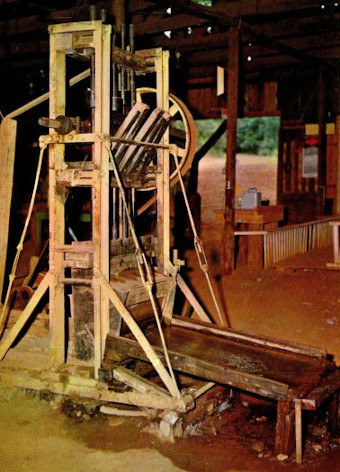Gold prospecting with a pan or sluice box is relatively easy. Regardless of your level of experience, you can expect to uncover some placer gold at a good prospecting site. But pans and sluice boxes are entirely ineffective when it comes to extracting gold from rock. Picks and shovels can work, but pose challenges. This is what necessitated the invention of the stamp mill.
Today, stamp mills are rarely used. Nevertheless, they continue to fascinate gold mining enthusiasts. A few devoted miners still use stamp mills to find gold. In this article we will provide a thorough overview of stamp mills and their history.

What Is a Stamp Mill?
A stamp mill is a mechanical device used to separate gold from rocks and ore. It features a number of sizable steel stamps. These stamps are attached to powerful battering arms, which raise and lower the stamps. When the stamps are lowered they come crashing down with a powerful force, crushing the material beneath them. Chunks of rock are broken up in this manner when they are poured into a stamp mill.
Once the rock is crushed into tiny pieces then it gets spread across a mercury-coated table. This mercury coating attracts any gold that may be present.
Stamp Mill History
The earliest evidence of stamp milling can be traced back to Persia. From there, Muslim travelers spread it to Spain. It even found its way to Africa overtime. The stamp mills used by these early Muslim miners were quite different in design to what we are familiar with today.
The modern stamp mill was introduced by Almarin Paul in the 1860s. This coincided with the gold fever which swept America in the 19th century. As such, it wasn't long before the stamp mill became a fixture of mining in the United States. Its popularity also extended to Australia and the United Kingdom.
As gold fever subsided, use of stamp mills decreased. Some miners continued to use them into the 20th century, but most miners gradually switched to newer and more efficient methods. There is a small contingent of enthusiasts who practice stamp milling to this day.
Where Can You See a Stamp Mill?
Pictures of stamp mills are easily available online. You can even find video exhibitions of them. It's also possible to see one up close and in person.
There are mining museums located across America. These museums tend to house important artifacts from America's gold mining history. Among the top mining museums in the United States are the Sterling Hill Mining Museum in Ogdensburg, New Jersey and the Western Museum of Mining and Industry in Colorado Springs, Colorado. Both of these museums have stamp mills. We suggest calling your chosen museum in advance to make sure that their stamp mill is on display and not out for maintenance or on loan.
Conclusion
The stamp mill is an older and hardly-used method of extracting gold from rocks. However, its role in the growth of America's mining industry cannot be understated. In fact, mining would be very different across the world were it not for the introduction of stamp mills. For this reason, we believe that any mining enthusiast should seek to familiarize themselves with stamp mills, their operation, and their history.
